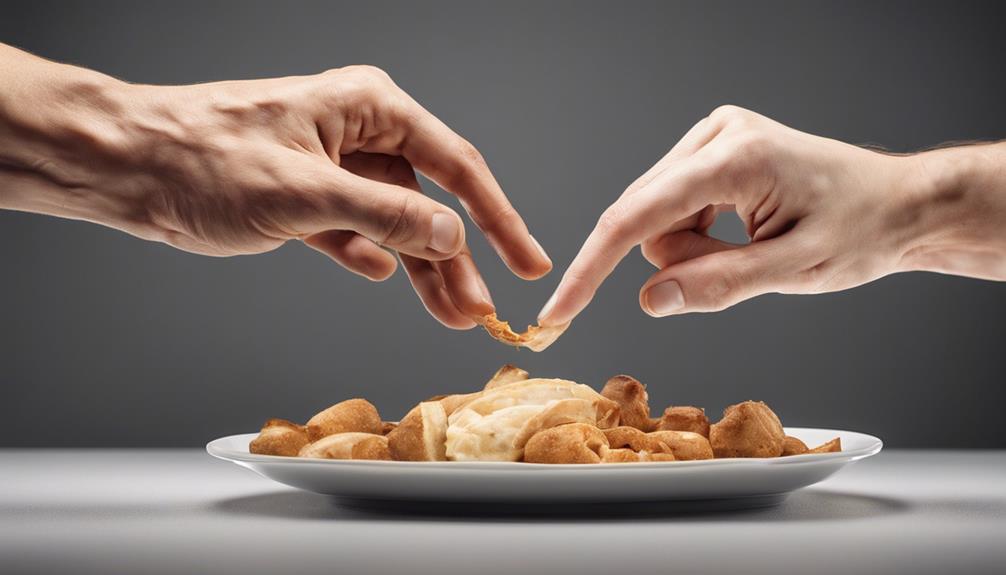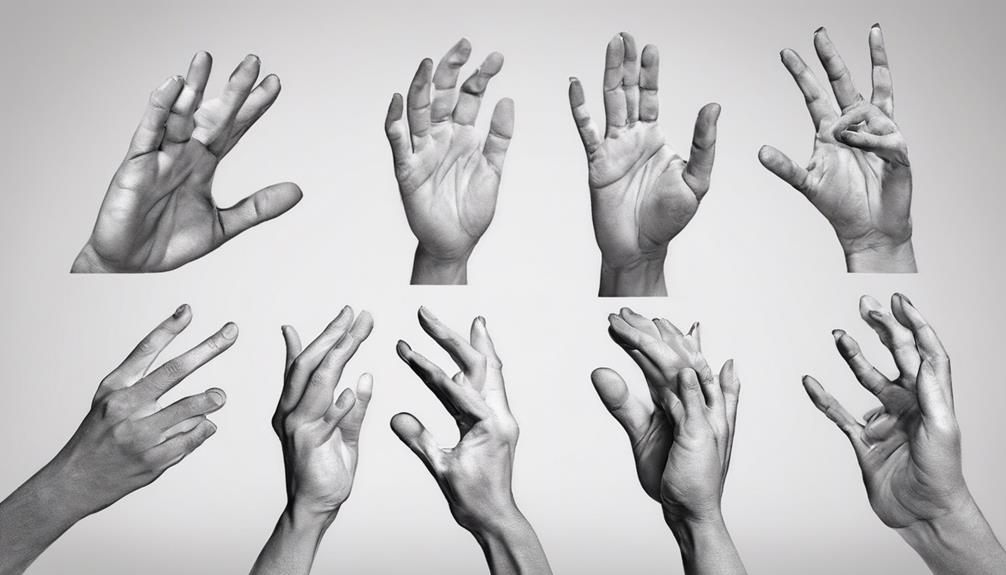When you learn sign language, it’s interesting to discover that American Sign Language (ASL) has its own distinct grammar and syntax, which makes it a vibrant and expressive mode of communication.
Wondering how to sign 'more food' in ASL? Let's explore the simple yet powerful signs that can convey this message effectively.
By mastering these signs, you'll not only enhance your ability to communicate with individuals who are deaf or hard of hearing but also gain a valuable skill that can be used in various contexts.
Key Takeaways
- Signing 'more' and 'food' indicates desire for additional food
- Regular practice reinforces sign language fluency
- Enhances communication during meal times effectively
- Encourages early language development and reduces frustration in young children
Benefits of Learning 'More Food' Sign
Learning the 'more food' sign provides infants and toddlers with a powerful tool to effectively communicate their hunger and desire for additional food. By mastering this sign, children can express their specific needs and preferences during meal times, enhancing parent-child interaction. This communication tool not only reduces frustration and tantrums in young children struggling to convey their hunger verbally but also encourages early language development. Through signing 'more food,' children strengthen the connection between words and actions in their minds.
Incorporating the 'more food' sign into daily routines can transform mealtime into a positive and enjoyable experience for both parents and children. It empowers children to participate actively in expressing their hunger and food preferences, fostering a sense of independence and confidence. By understanding and responding to their needs promptly, parents can build a strong bond with their children and create a harmonious mealtime environment that promotes healthy eating habits.
Basic Signs for 'More' and 'Food

Upon mastering the signs for 'more' and 'food' in American Sign Language (ASL), infants and toddlers can effectively communicate their hunger and food preferences during meal times. The sign for 'more' involves tapping the fingertips of both hands together, while signing 'food' is done by tapping the fingertips of one hand to your mouth. By combining these two signs sequentially, one can convey the desire for 'more food' in ASL. Teaching these signs to young children can empower them to express their need for additional food clearly. This enhanced mode of communication not only aids in understanding children's needs but also reduces frustration for both the children and their caregivers.
| Sign | Description |
|---|---|
| More | Tap fingertips of both hands together |
| Food | Tap fingertips of one hand to mouth |
| More Food | Sign 'more' followed by 'food' |
Putting It Together: 'More Food
Putting the signs for 'more' and 'food' together in American Sign Language creates a powerful communication tool for expressing the desire for additional food. This combination of signs is essential for conveying hunger or requesting more to eat effectively.
When signing 'more food,' follow these steps:
- Start by signing 'more' by tapping your fingertips together, indicating the need for an increase in quantity.
- Then, sign 'food' by tapping your hand towards your mouth, specifying the type of item desired.
- The combination of these signs clearly communicates the request for additional food.
- Practice signing 'more food' during meal times to reinforce the association between the signs and the action of eating, facilitating smoother communication between individuals.
Incorporating signs like 'more food' into daily routines can significantly enhance communication and reduce frustration for both children and caregivers, making mealtime interactions more efficient and enjoyable.
Practice Tips for Fluent Signing

To improve our signing fluency, we should incorporate consistent practice techniques into our daily routine.
One effective method is to practice signing 'more food' by combining the signs for 'more' (tapping fingertips together) and 'food' (tapping hand towards mouth). It's helpful to repeat the 'more food' sign during meal times to reinforce the association between the signs and the action.
Positive reinforcement, like praise or a small reward, can motivate us to continue practicing and successfully signing 'more food'. Additionally, signing together with a partner can make the practice more engaging and enjoyable. Encouraging imitation and making it a fun activity can help in mastering the sign.
Consistency is key, so practicing the 'more food' sign regularly will aid in becoming fluent in its use. By following these practice tips diligently, we can enhance our signing skills and communicate more effectively in sign language.
Using 'More Food' in Contexts
When using the sign language for 'more food' in daily interactions, it's essential to remember to combine the signs for 'more' and 'food' to effectively communicate the desire for additional food.
Here are some ways to incorporate 'more food' into various contexts:
- Practice Regularly: Use the signs during meal times to reinforce the association between 'more' and 'food.'
- Encourage Usage: Prompt your child to use the signs when they want seconds or more snacks.
- Make it Fun: Integrate the signs into play activities involving food to make learning enjoyable and engaging.
- Be Consistent: Use the signs consistently in different situations to help your child understand and effectively use them.
Frequently Asked Questions
What Is the Sign Language for More Food?
We can sign 'more food' in American Sign Language by combining the signs for 'more' and 'food.' This involves tapping our fingertips together in a pinching motion for 'more' and moving our hand towards our mouth for 'food.'
By seamlessly blending these signs, we convey the desire for additional food.
Teaching infants and toddlers this sign can help them express hunger or request more food effectively.
How Do You Sign More in Asl?
When we sign 'more' in ASL, we tap our fingertips together.
It's a versatile sign often used by infants and toddlers to express a desire for additional things.
Mastering this sign can enhance communication skills early on.
How Do You Sign Food in Asl?
When signing 'food' in ASL, we bring fingertips together and tap towards the mouth. This simple gesture allows young children to express their hunger or mealtime needs effectively. Teaching this sign early aids in communication development and reduces frustration.
Incorporating signs like 'food' enables infants to convey desires before verbal abilities develop. Enhancing communication through signs fosters strong bonds and promotes language growth in children.
What Is Baby Sign Language for Food?
When teaching baby sign language for food, it's essential to introduce signs like 'eat' and 'more' early on to assist infants in expressing their hunger or desire for additional food. By incorporating these signs as early as 6-8 months, parents can better understand their child's needs during meal times.
Consistent use of food-related signs can enrich a child's vocabulary and comprehension of mealtime concepts, making mealtimes more interactive and enjoyable.
Is knowing how to sign ‘Pizza’ in American Sign Language helpful in knowing how to sign ‘More Food’?
Yes, knowing how to sign “pizza” in American Sign Language can be helpful in knowing how to sign “more food.” In ASL, the sign for “pizza” can be incorporated into the sign for “more food” to indicate a specific desire for more of that particular type of food. Learning ASL pizza signs can enhance your communication in food-related conversations.
Conclusion
In conclusion, learning how to sign 'more food' in American Sign Language can greatly benefit caregivers and infants.
By mastering the basic signs for 'more' and 'food' and combining them, communication becomes clear and effective.
Practice is key to fluent signing, and using 'more food' in various contexts can further enhance understanding.
So, let's keep practicing and incorporating this important sign into our daily interactions for better communication.











